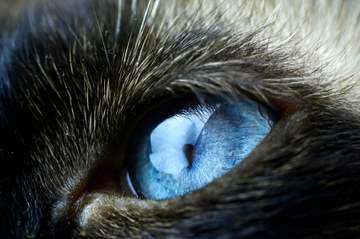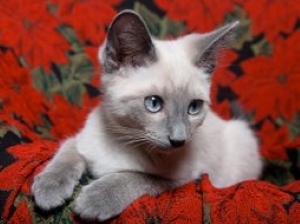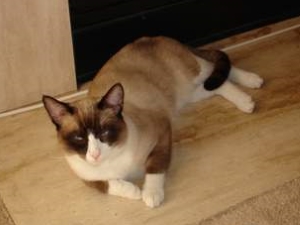- Home
- Meezer Musings
- July 2022
Meezer Musings: July 2022
Oh, My Ears and Whiskers!
... the White Rabbit was still in sight, hurrying down it. There was not a moment to be lost: away went Alice like the wind, and was just in time to hear it say, as it turned a corner, 'Oh my ears and whiskers, how late it's getting!'
Lewis Carroll: Alice in Wonderland
Fun Facts About Cat Senses
Welcome to July's Meezer Musings! Today, Saturday 30th July, is the International Day of Friendship. Greetings to Meezer friends everywhere, wherever you may be in the world.
July is often a feast for the senses, so this month, we're going to talk sense! Cat sense, in fact - we're going to take a lighthearted look at the senseS - the things a cat uses to see, smell, hear, taste, touch, and navigate its world - including, of course, the 'ears and whiskers' mentioned by Alice In Wonderland's White Rabbit in our opening quote.
Related to this topic, there's also a recommendation for summer reading, and as it's been so unusually hot in so many places recently, I've included our Topical Tips for the heat once again. (You may have seen them in May's Meezer Musings, but if you missed them first time around, you'll find them below.)
So, like the White Rabbit, let's start with the ears ...
The Ears and Hearing
Did You Know? Cats can hear sounds up to 1.6 octaves higher than a human can.
A cat's hearing is very acute - cats have an extraordinarily broad range of hearing which allows them to hear very high-pitched sounds of up to 1.6 octaves above human hearing.
A cat's ears are able to swivel and independently point backwards, forwards or sideways. This allows cats to accurately judge the source of any sound - for example, the rustle of moving prey. At a distance of three feet they're able to pinpoint the location of the sound to within three inches - very handy in locating moving mice!
It's sometimes said that white cats with blue eyes (though not generally Siamese cats) are deaf but this isn't entirely true, although they do tend to have more deafness than white cats with eyes of other colors.
Which brings us on to ...
 photo: © iStockphoto | oonal
photo: © iStockphoto | oonalThe Eyes and Sight
Did You Know? Cats can't detect colors as well as humans can.
Cats have a layer of tissue in their eyes called the tapetum lucidum, which enhances the amount of light entering the eye. This allows them to see very well in the dark - much better than most humans can - but also seems to reduce the effectiveness of their eyes in broad daylight.
Cats are often said to see only shades of gray but this isn't exactly true - it's thought that cats can distinguish well between blues and greens but find shades of reds and pinks confusing. Rather like a human who is color blind, cats see reds and pinks as shades of green, and purple as just another shade of blue.
It's thought that cats are shortsighted, making it difficult to see things in the far distance but much easier to focus on their prey.
When hunting, they also rely on ...
The Nose and Smell
Did You Know? A cat's sense of smell is up to 16 times as powerful as a human's.
Humans have around 5 million odor-sensitive cells in their noses, whereas cats have between 45-200 million!
Cats also have a scent organ in the roof of their mouths - the vomeronasal or Jacobson's organ. This is responsible for that curious, open-mouthed expression where they wrinkle their muzzle and pull their lips back when they smell something out of the ordinary.
This is called gaping, also known as the Flehmen response, a combination of smelling and tasting. Cats have a pair of ducts on the roof of their mouths behind the incisor teeth leading up to the vomeronasal organ and from there up into the nose. The Flehmen response opens these ducts, allowing the scent to travel upwards to be 'tasted' and smelled at the same time.
The Mouth and Taste
Did You Know? Cats are missing the gene that allows them to taste sweetness.
In 2005 it was discovered that cats are missing one of two proteins on a gene responsible for the ability to sense sweetness. This missing protein - a gene deletion or mutation - is found in the whole cat family but not in other animals; the relevant taste buds can still be found but are inactive in cats.
Some scientists believe this may be why the cat family evolved as hunters and obligate carnivores (meaning they must eat meat to survive) as this alteration in their sense of taste may have caused them to avoid carbohydrate-rich, sweet, plants and diverted them towards protein-rich diets, which would have had more flavor.
Hunting brings us on to ...
The Whiskers - Touch, Navigation and Hunting
Did You Know? A cat's whiskers help them to feel, 'see', and navigate their world.
Cats have four sets of whiskers, technically known as vibrissae, mainly found on their upper lips on either side of the nose. There are approximately twenty-four of these, in four rows. Some cats have more, some less.
In addition to these they have a few whiskers on each cheek, some on the chin, and around 6-8 whiskers in clumps above the eyes as well as others on the inside of their 'wrists' and the back of their legs.
The whiskers have very deep roots with many nerve endings, making them extremely touch-sensitive. They send signals to the brain which then creates a virtual, three-dimensional map of the cat's surroundings, including the objects they come in contact with around them and even air flow.
So the whiskers help with both touch and navigation, and also with hunting. Whiskers provide a cat with detailed information about its prey, even if that prey (like a mouse) is too close for the cat to actually see it.
Summer Reading
If you'd like to know more about cat senses (and many other interesting facts about cats and how they relate to their world), I can thoroughly recommend John Bradshaw's Cat Sense.
John Bradshaw is one of the world's leading animal behaviorists and in this book he goes into great detail about how cats relate to humans and what they need to make them happy in their lives.
It's not a quick read, but it is an excellent reference guide to everything that makes a cat, a cat.
And still on the subject of senses ...
Topical Tips for Summer Heat
Cats usually enjoy warm weather and are fairly heat tolerant, but can suffer from dehydration and heatstroke when temperatures soar.
With that in mind, here are ten tips for keeping your cat cool, healthy and happy in the summer months.
- Supply plenty of fresh cold water. This is always important, but in hot weather water evaporates very quickly. Check bowls regularly; clean them out and fill them up. Some cats like ice cubes
added to their water, some don't, so to experiment, provide a choice of iced and non-iced water. Don't use too
much ice though - one or two cubes is plenty to keep the water fresh without
over-chilling it.
- Feed wet food. Some cats don't drink enough, which can be a problem in hot weather. If you usually feed dry foods, consider switching to wet meals and adding water to them. Many cats love licking gravy, and adding water is a sneaky way of getting more fluid in.
- Provide shade and airflow. Indoors (and outdoors, if your cat's allowed out) make sure there's a cool, quiet, shady area they can retreat to. Keep curtains closed or shades drawn when the sun's on the windows. Rooms with ceiling fans for airflow are helpful too.
- Make cool spots. Many cats love lying on cool, tiled kitchen floors when it's hot, others choose to curl up in sinks, showers or baths. Laying wet towels down in these areas can help. It's possible to buy self-cooling mats for pets, but you can create cool spaces yourself by placing ice packs in cotton pillowcases in places where you cat likes to lie, or filling water bottles with ice cold water and placing them in cardboard boxes for your cat to find and use if they need to.
- Avoid too much play. Exercise generates heat, so keep play to a minimum in hot weather.
- Groom cats daily. In long-haired cats especially, matted fur can trap heat. Fur with no tangles allows air to flow freely through the coat. Daily brushing (for all cats) removes excess fur and helps to keep them cool.
- Check your outside buildings.
Inspect sheds, greenhouses, and summerhouses before closing them up.
Cats often creep inside for shade, but will dehydrate and die very
quickly in hot enclosed spaces without water.
- Avoid parked cars. Never leave cats alone in parked cars. On trips to the vet or on vacation, make sure the cat's in a secure cat carrier, use air-conditioning if you have it, open the windows if you have to park, and stay with the cat to keep an eye on it.
- Check for dehydration. Pinch the skin at the back of your cat's neck - it should spring back immediately. If it doesn't, chances are they're dehydrated. Dehydration can be serious so always seek veterinary advice.
- Watch for signs of heatstroke.
Panting, drooling, vomiting, listlessness or lethargy, dilated pupils
and a rapid heartbeat are all signs of heatstroke. If you notice any of
these things take your cat to the vet immediately. You can help to cool your
cat down on the way by sponging their heads and coats with cold, damp,
towels.
Tail End ...
I'd like to finish with an apology to followers of our Meezers on a Monday posts on the Life with Siamese Cats Facebook page. Earlier this week all comments on those posts, going back several months, were spammed by two different entities appearing to advertise Siamese kittens for sale.
The spam comments have now been removed, and the spammers have been reported to Facebook and banned from the page. My apologies to you if yours was one of the comments affected.
That's all for this month. I'll be back at the end of August but meanwhile, enjoy the rest of the summer and stay safe in the heat!
Caroline
Missed a Meezer Musings? A list of previous newsletters can be found here.
Some of the articles and newsletters on this site may contain links to products I think you may enjoy. If
you purchase through these links I receive a small commission, but there's
no extra cost to you. Find out more on the Affiliates Disclosure page.
Have You Discovered Our Newsletter?
If not, why not? Subscribe to our email newsletter, Meezer Musings, to stay in touch, be the first to see new information and pages as they come out, and read the things we only talk about in the newsletter.
Learn more about it on our Newsletter Sign-Up page.




